"Fibers" is the collective term for all kinds of fine fibers and filaments. Fibers are used as a starting material for clothing, household textiles and industrial goods.
Fibers are divided into natural and manmade fibers.
With water contents of 5 - 14%, fibers, especially those of vegetable origin, belong to water content class 2 (WCC 2). Due to their processing, they are goods in which respiration processes are suspended, but in which biochemical, microbial and other decomposition processes still proceed; they thus exhibit 3rd order biotic activity (BA 3). Fibers require particular temperature, humidity/moisture and possibly ventilation conditions (SC VI).
Fibers are transported in standard containers, subject to compliance with limits for water content of goods, packaging and container floor.
Transport instructions and damage
Packaging
Fibers are usually transported in bales, which are compressed to different degrees and are tied firmly with steel straps or wire. To protect bales from contamination and damp, they are wrapped in jute or plastic fabric, and perforated plastic films are also used to regulate bale moisture content. Care must be taken during container stuffing to ensure that the bale strapping is not damaged. Undamaged strapping is essential to maintain compression of the bales during transport. If the strapping is broken, compression is diminished, which results in an increased supply of oxygen to the inside of the bales. This in turn increases the risk of self-heating/spontaneous combustion of the bales.
Hygroscopicity
Table 30 shows the water contents for some natural fibers.
| Natural fiber | Water content in % | Equilibrium moisture content in % |
| Cotton | 7.85 - 8.50 | 65 |
| Esparto | 7.00 - 14.00 | 65 |
| Flax | 10.00 - 12.00 | 65 |
| Flax tow | 10.00 - 12.00 | 65 |
| Hemp | 10.00 - 12.00 | 65 |
| Jute | 12.50 - 14.00 | 65 |
| Kapok | 8.50 | 65 |
| Coconut fiber | 12.00 | 65 |
| Manila hemp | 5.00 - 12.00 | 55 |
| Palm fiber | 12.00 | 65 |
| Piassava | 16.00 | 70 |
| Raffia | 12.00 | 65 |
| Ramie | 7.50 - 12.00 | 65 |
| Sisal hemp | 5.00 - 12.00 | 55 |
| Chair cane (Rattan) | 10.00 - 12.00 | 65 |
| Absorbent cotton | 7.85 - 8.500 | 70 |
Table 30: Water contents of some natural fibers
Natural fibers must be protected from all forms of moisture, whether excessive humidity or seawater, rain or condensation water, in order to prevent decay, discoloration, mold, mildew stains and rot. When exposed to moisture, fibers tend to discolor rapidly, ultimately turning black, they assume a musty odor and become moldy and mildewed; they lose tensile strength and elasticity and, to a greater or lesser degree, become susceptible to decay. Where bales are strapped with steel straps or wires, corrosion and consequently rust damage may occur.
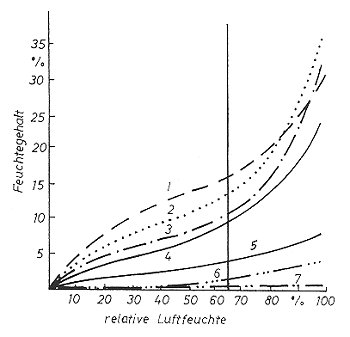
| Figure 175: Sorption isotherms for various fibers
[4] 1 - Wool 2 - Viscose 3 - Natural silk (Bombyx silk) 4 - Cotton 5 - Polyamide 6 6 - Polyacrylonitrile fiber 7 - Polyester fiber |
Fig. 175 shows the sorption isotherms for some fibers. These show that natural fibers, such as cotton, wool and Bombyx silk, exhibit markedly hygroscopic behavior, while manmade fibers exhibit lower hygroscopicity. Natural fibers may absorb large quantities of water vapor without feeling damp. At a relative humidity of 95%, cotton, for example, may increase its water content to 25 - 27% without feeling wet. Swelling may cause cotton bales to increase in volume by 40 - 45%. Such levels of swelling can make containers burst.
| Fiber | Swellability in % |
| Cotton | 40 - 45 |
| Flax | up to 20 |
| Hemp | up to 30 |
| Jute | up to 34 |
| Wool | up to 30 |
| Natural silk | 20 - 40 |
| Asbestos | 0 |
| Viscose fiber | 85 - 120 |
| Cuprammonium rayon fiber | 85 - 120 |
| Acetate fiber | 20 - 25 |
| Glass silk | 0 |
| Polyvinyl chloride fibers | 0.1 |
| Polyacrylonitrile fibers | 4.0 |
| Polyamide fibers | 13.0 |
| Polyester fibers | 3.0 - 4.0 |
Table 31: Swellability of various fibers
Fire hazard properties
Natural fibers and manmade fibers based on natural fibers have a tendency to undergo self-heating/spontaneous combustion (see Section 13.6). However, fires have also frequently been caused by external ignition. The root cause may be found in the structure of the fibers themselves: their high crude fiber content, which in the case of vegetable fibers consists of cellulose, accompanying substances, such as oils, fats and tallow, the influence of moisture, poor thermal conductivity and an oxygen supply, which is provided by the well-developed lumen of vegetable fibers or the medulla of animal fibers (see Figs. 176, 178). Another factor is the activity of microorganisms. Even traces of vegetable or animal oils or fats are sufficient to bring about self-heating by the degradation of organic substances. Wool, for example, can never be completely degreased.
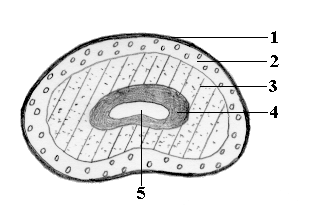 |
Figure 176: Cross-section through a cotton fiber [4]
|
|||||||||||||||
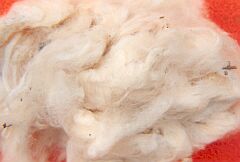 |
Figure 177: Ginned, i.e. deseeded, cotton; Photo: U. Scharnow |
|||||||||||||||
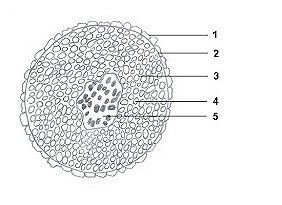 |
Figure 178: Cross-section through a wool fiber [4]
|
All natural fibers, with the exception of asbestos, share the following properties:
- a low ignition temperature, which means that sparks or an unextinguished cigarette end are enough for ignition
- rapid propagation of the fire to all bales in the event of external ignition
- deep penetration of the fire into the bales
- increased susceptibility to fire after contact with fats or drying oils
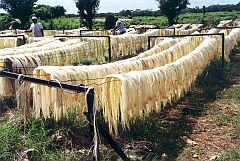 |
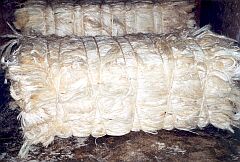 |
| Figure 179: Sisal drying station in Mexico; Photo: Ragna Scharnow |
Figure 180: Sisal bales: fiber bundles are arranged in parallel in order to avoid breakage. The bales have no wrapping. Photo: Ragna Scharnow |